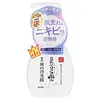What's inside
What's inside
 Key Ingredients
Key Ingredients

 Benefits
Benefits

 Concerns
Concerns

 Ingredients Side-by-side
Ingredients Side-by-side

Dipotassium Glycyrrhizate
HumectantWater
Skin ConditioningPotassium Cocoyl Glycinate
Butylene Glycol
HumectantSorbitol
HumectantGlycerin
HumectantDisodium Cocoamphodiacetate
CleansingGlycine Soja Germ Extract
EmollientGlycine Soja Extract
Skin ConditioningMagnesium Ascorbyl Phosphate
AntioxidantDisodium EDTA
Alcohol
AntimicrobialSodium Lauroyl Methylaminopropionate
CleansingPotassium Hydroxide
BufferingPhenoxyethanol
PreservativeDipotassium Glycyrrhizate, Water, Potassium Cocoyl Glycinate, Butylene Glycol, Sorbitol, Glycerin, Disodium Cocoamphodiacetate, Glycine Soja Germ Extract, Glycine Soja Extract, Magnesium Ascorbyl Phosphate, Disodium EDTA, Alcohol, Sodium Lauroyl Methylaminopropionate, Potassium Hydroxide, Phenoxyethanol
Water
Skin ConditioningGlycerin
HumectantIsopentyldiol
HumectantDiglycerin
HumectantPPG-14 Polyglyceryl-2 Ether
EmulsifyingAscorbyl Glucoside
AntioxidantAllantoin
Skin ConditioningAloe Barbadensis Leaf Extract
EmollientPerilla Ocymoides Leaf Extract
TonicCitrus Iyo Fruit Extract
EmollientHoney
HumectantSodium Hyaluronate
HumectantPolyquaternium-61
Skin ConditioningLonicera Caprifolium Flower Extract
PerfumingLarix Kaempferi Root Bark Extract
Skin ConditioningPrunus Persica Leaf Extract
EmollientSoluble Collagen
HumectantPolyglyceryl-10 Eicosanedioate/Tetradecanedioate
Skin ConditioningButylene Glycol
HumectantPEG-60 Hydrogenated Castor Oil
EmulsifyingXanthan Gum
EmulsifyingCitric Acid
BufferingSodium Citrate
BufferingPEG-25 Avocado Oil Glyceryl Esters
EmulsifyingTocopherol
AntioxidantPhenoxyethanol
PreservativeEthylparaben
PreservativeMethylparaben
PreservativeParfum
MaskingWater, Glycerin, Isopentyldiol, Diglycerin, PPG-14 Polyglyceryl-2 Ether, Ascorbyl Glucoside, Allantoin, Aloe Barbadensis Leaf Extract, Perilla Ocymoides Leaf Extract, Citrus Iyo Fruit Extract, Honey, Sodium Hyaluronate, Polyquaternium-61, Lonicera Caprifolium Flower Extract, Larix Kaempferi Root Bark Extract, Prunus Persica Leaf Extract, Soluble Collagen, Polyglyceryl-10 Eicosanedioate/Tetradecanedioate, Butylene Glycol, PEG-60 Hydrogenated Castor Oil, Xanthan Gum, Citric Acid, Sodium Citrate, PEG-25 Avocado Oil Glyceryl Esters, Tocopherol, Phenoxyethanol, Ethylparaben, Methylparaben, Parfum
 Reviews
Reviews

Ingredients Explained
These ingredients are found in both products.
Ingredients higher up in an ingredient list are typically present in a larger amount.
Butylene Glycol (or BG) is used within cosmetic products for a few different reasons:
Overall, Butylene Glycol is a safe and well-rounded ingredient that works well with other ingredients.
Though this ingredient works well with most skin types, some people with sensitive skin may experience a reaction such as allergic rashes, closed comedones, or itchiness.
Learn more about Butylene GlycolGlycerin is already naturally found in your skin. It helps moisturize and protect your skin.
A study from 2016 found glycerin to be more effective as a humectant than AHAs and hyaluronic acid.
As a humectant, it helps the skin stay hydrated by pulling moisture to your skin. The low molecular weight of glycerin allows it to pull moisture into the deeper layers of your skin.
Hydrated skin improves your skin barrier; Your skin barrier helps protect against irritants and bacteria.
Glycerin has also been found to have antimicrobial and antiviral properties. Due to these properties, glycerin is often used in wound and burn treatments.
In cosmetics, glycerin is usually derived from plants such as soybean or palm. However, it can also be sourced from animals, such as tallow or animal fat.
This ingredient is organic, colorless, odorless, and non-toxic.
Glycerin is the name for this ingredient in American English. British English uses Glycerol/Glycerine.
Learn more about GlycerinPhenoxyethanol is a preservative that has germicide, antimicrobial, and aromatic properties. Studies show that phenoxyethanol can prevent microbial growth. By itself, it has a scent that is similar to that of a rose.
It's often used in formulations along with Caprylyl Glycol to preserve the shelf life of products.
Water. It's the most common cosmetic ingredient of all. You'll usually see it at the top of ingredient lists, meaning that it makes up the largest part of the product.
So why is it so popular? Water most often acts as a solvent - this means that it helps dissolve other ingredients into the formulation.
You'll also recognize water as that liquid we all need to stay alive. If you see this, drink a glass of water. Stay hydrated!
Learn more about Water